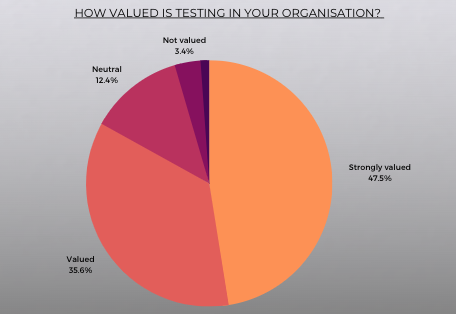View the report in PDF here: Quality Testing
THE EUROPEAN SOFTWARE TESTING BENCHMARK REPORT 2022
PART II: Quality in Software Testing
Quality in Software Testing ensures that every product and service provided by an organisation meets the best quality standards possible. Quality assurance or QA focuses on improving the software development process and making it more efficient and productive for the customers. It is then essential that businesses incorporate the best practices and put quality at the heart of their initiatives.
Hence, how much time and resources are dedicated to quality assurance in software companies? How useful, and how valued, is quality in organisations?
To answer all your questions, we, at Software Testing News, are proud to share with you the final results of the second stage of our European Software Testing Benchmark Report 2022 on Quality Testing.
Thank you to everyone who took the time to participate, we hope you’ll find it insightful!
Testing Professionals & Quality
Although Quality Assurance (QA) and Testing are closely intertwined, they are not the same concept. Testing focuses on code quality and covers the outputs of software delivery while QA ensures that all the appropriate processes and procedures are in place to deliver quality products and services.
Testing needs to incorporate quality within its software delivery lifecycle (SDLC) to achieve the best results possible. Among the 170 IT professionals surveyed, 52% are using testing ‘a great deal’, 26% ‘a lot’, and 9% ‘a great amount. Only a very small percentage are not using it at all or very little. It will then be interesting to see how these professionals are implementing quality and how valued it is in their business.

As seen in the graphic below, our research showed that a majority of IT professionals are allocating around 31-50% of their budget to testing and quality assurance while only 2% are devoting more than 90% of their budget to it. This number is quite disappointing as it was proven time after time that implementing testing and quality processes would help enhance the software development and leave less room for errors.
Even though there is definitely more done to adopt testing and quality in organisations, there is still a lot of work to be accomplished in order to have Quality Assurance incorporated at the very early stages of the development lifecycle.

QA Resources in Business
Moreover,among the professionals surveyed, we have tried to access the level of QA resources available within an organisation and how are these used and valued. The research showed that 88% of respondents have adopted QA and Testing practices in place for agile development and 63% of their businesses have an Operation Test Centre of Excellence (TCOE).
This reveals a desire to introduce more quality within the software development lifecycle and reach for more efficient and productive results that will better meet customers’ expectations. The standardisation of TCOE will bring testing infrastructure and resources together in the goal of achieving excellence in testing functions. Hopefully, more companies will implement one in the near future.

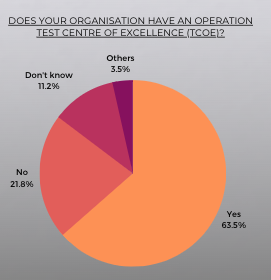
To showcase the importance of Testing Centers of Excellence, TCOE gathers groups of testing specialists that will be leveraging leverage testing knowledge, technology, methodology, and resources in order to help companies optimize application quality and performance, improve alignment between business and IT, and increase QA efficiency. TCOE will also show the actual value of testing and QA and so, lead organisations to do more with their existing QA budgets, tools, environments, and people.
Among the respondents who are actually using a testing center of quality within their business, 40% have found it to be extremely useful, and 25% find it very useful. Only a mere 5% do not think having a TCOE would help their business improve their overall quality and testing processes.

Despite not having a lot of budgets allocated to testing and quality, around 82% of professionals are extremely and very reliant on their QA and testing (QAT) resources. Besides, around 83% also agree that they are a necessity for their business.
It is then clear that QA and Testing are gaining in importance as these resources can effectively prevent re-work, expensive delays, or future failures. Having an appropriate investment in quality assurance will lead to improved technical requirements, development, and design of software products, as well as will enhance the business, and satisfy customers.
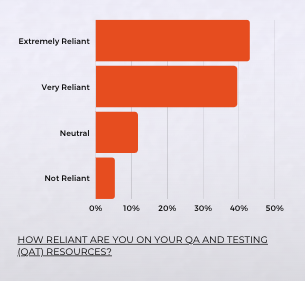

Implementing QA
Our research on Quality in Software Testing led us to wonder how much of these QAT resources are used during the software development lifecycle. The majority of the professionals surveyed stated that they use it during the deployment phase – which is quite late in the development lifecycle.
However, 21% of respondents – the second majority – are using the QAT resources in every part of the SDLC, which is very hopeful for the future as testing and QA should be integrated at every stage to prevent errors and defects.
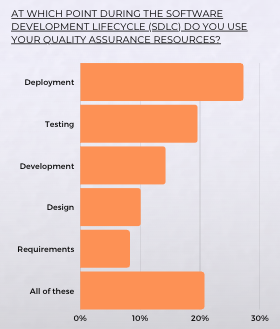
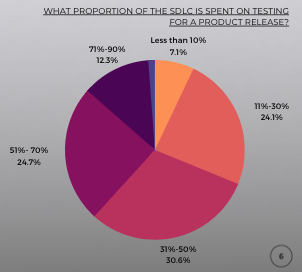
It is also positive to see that most respondents are spending 31% to 50% of the SDLC on testing for a product release, while 25% of professionals are spending 51% to 70% of the SDLC on testing. This shows that testing and quality assurance are slowly becoming more of a priority for businesses all around Europe.
Yet, QA and Testing still have a long way to go, and to reach complete success and seamless integration, organisations must face some challenges.
According to our research, it is clear that the main difficulty comes from process (21%), followed closely by manpower (18%), tools (17%), and regulations (16%). Funny enough, only 7% of respondents believe that budget constricts the QAT approach while we saw that not enough budget was allocated to testing and quality.
It is also interesting to see that around 16% of the professionals surveyed have stated that all of these are a challenge to the good implementation of QA and Testing in their business.

The Value of QA
After reviewing how and how much quality assurance is employed within organisations, we can see that an overwhelming majority of the respondents feel that testing and QA are valued in their business. Hence, it is vital to showcase the growing importance of QA as it can reinforce a company’s reputation as a high-quality supplier to its customers as well as strengthens employee commitment.
Having a good QA team and processes helps organisations in becoming successful by providing excellent products, lower costs, and improved business efficiency. QA is an essential part of software development and should be treated as such.
